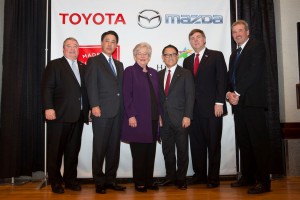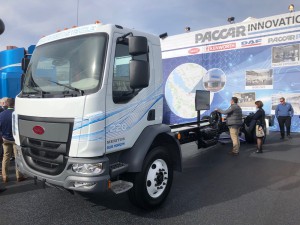
Toyota's Jim Lentz believes the auto industry is putting too much stock – and money – into electric vehicles.
By various estimates, there should be as many as 100 all-electric vehicles on the market by the end of 2020, with scores more plug-ins and conventional hybrids already available. And that could pose a major challenge for automakers who are investing billions into the market to build battery-based vehicles. That includes Toyota which is investing about $1 billion to open up a new plant in U.S. in a partnership with Mazda that will, among other products, produce a new line-up of battery-electric vehicles, or BEVs.
The question is whether all that money could be going down a rathole. For the moment, at least, Tesla appears to be the only automaker making any money on battery vehicles, as a number of industry leaders pointed out during a series of events in Detroit this week.
That included Jim Lentz, the CEO of Toyota North America, who warned that, “It’s going to be a battle,” as manufacturers struggle to grab customers in a market where “There’s not much growth.”
Lentz tried to put the situation into perspective by pointing out that only the Tesla Model 3, of all the electrified models now on the market currently is generating more than 10,000 sales per month. And of the 94 “electrified” vehicles on the market – including hybrids, plug-ins and pure battery-electric vehicles – only six top 2,000 a month.
(Toyota staying in car market for the long haul. Click Here for the story.)
Proponents of battery technology are quick to note that sales of EVs surged to 600,000 worldwide last year. The Chinese market saw demand for plug-based products double while the U.S. had double-digit growth of its own. But Lentz remains skeptical that the pace will pick up quickly enough to take the pressure off the industry.

Officials are all smiles after Toyota and Mazda announced it would build its new plant in Alabama. The site will build some electric vehicles.
“With EVs, I think it’s going to be a while,” Lentz forecast, before they account for a significant share of the market. “I think we’ve over-stated our belief EVs will take over the world.”
Lentz admitted that everything related to the transportation industry has become increasingly difficult to predict. In a Q&A session at the Automotive New World Congress, he pointed out some bad calls on his own part. At the beginning of the decade he anticipated that the world would reach “peak oil,” the point at which global supplies start to diminish, by 2025, with fuel prices now on a path to $6 a gallon. Gas currently costs a third of that, largely because of a glut of oil.
But that’s only made it even more difficult to build demand for alternative powertrain technologies, said Lentz.
And it’s not just battery technology that’s proving a hard sell. Toyota is currently one of three manufacturers offering fuel-cell vehicles in the U.S., with its Mirai model launched in 2015. So far, however, Toyota has struggled to sell just a few 100 of those FCVs, and its competitors haven’t done much better.
“We were concentrating on passenger vehicles,” said Lentz, which have racked up only a few hundred sales. Part of the problem is a severe lack of places to fill up, with only about 40 hydrogen stations in the U.S., most in Southern California. “Maybe that’s not the best bet.”
(Click Here to see more about VW’s $800 million EV plant coming to Chattanooga.)
Toyota has decided to look at other options. While it will continue to offer the Mirai in limited markets, it last week announced plans to roll out 10 prototype hydrogen semi-trucks for use at the ports in Los Angeles and Long Beach. The State of California has set a mandate of eliminating all of the diesel trucks serving those shipping centers by 2025 and Toyota sees hydrogen power as a viable alternative – something the prototypes, developed in a partnership with Kenworth, will help prove out.

Toyota is teaming up with Paccar to develop a next-generation fuel-cell powered semi-truck to be used at the ports of Los Angeles and Long Beach.
“Maybe the best place to get hydrogen into the market,” said Lentz, “is in commercial vehicles. Then, when we build an infrastructure, we bring on passenger cars.”
Toyota isn’t the only company buying into that approach. Salt Lake City-based start-up Nikola Motors plans to launch production this year of its Class 8 truck, the Nikola One. And, to help support the fleet it will set up a network of hydrogen fueling stations across the country.
Lentz isn’t the only one expressing his concerns about the industry’s heavily funded rush into electrification.
“We have to reduce the amount of money everybody’s pouring in,” Don Walker, the CEO of Canadian-based mega-supplier Magna International, warned in his own speech to the World Congress.
Despite such concerns, few experts see the industry pulling back on the shift to alternative propulsion. Denis Le Vot, the CEO of Nissan North America, on Monday said his company will have eight BEVs in the market within five years and predicted it will soon be selling 1 million EVs annually, a number similar to what Volkswagen is looking at.
(To see more about Toyota’s clean hydrogen semi trucks, Click Here.)
Proponents believe the tipping point will be driven by three factors: the arrival of new long-range models, the growth of the public EV charging infrastructure, and a steady downward shift in EV prices.

“Lentz tried to put the situation into perspective by pointing out that only the Tesla Model 3, of all the electrified models now on the market currently is generating more than 10,000 sales per month. ”
That’s a false statement. Tesla is “bulding and delivering 10,000 cars per month.” No one knws how many they sold during the month, but since the vast bulk of customers come from the 2 year old waiting list, we know that only a small fraction of those who took delivery actually bought the caar that month. Nor is Tesla actually making a profit – they are simply rearranging their costs and putting them away from car costs